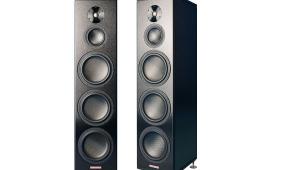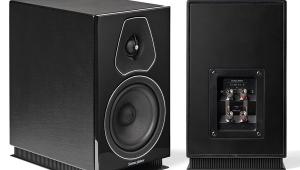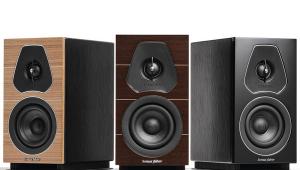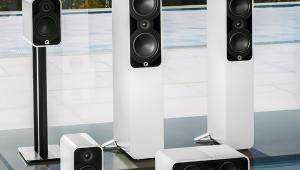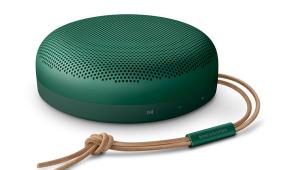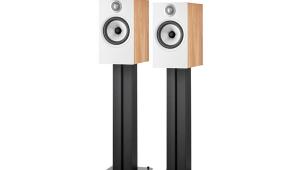Elipson Prestige Facet 14F
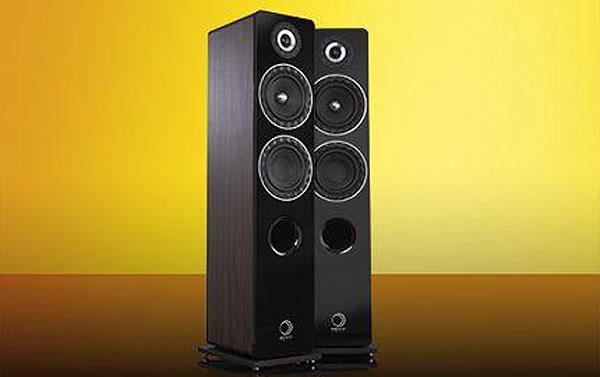
 Our story starts with Joseph Léon, a man decorated for bravery for his work in the French Resistance during World War II. Later, as managing director of Multimoteur, he began manufacturing loudspeakers called Conques (French for shells, due to their elliptical shape), and then changed the name to Elipson (‘ellipse’ and ‘son’, the latter being the French word for sound). The brand became quite iconic during the fifties and sixties, and Léon was awarded the National Order of Merit for his research and creations in 1962. The brand was reborn in 2008, when Philippe Carré and Eric James recreated it, with the accent on design and interior décor. The spherical Planet is the company’s iconic design, but it also makes more conventional and affordable box speakers such as the Prestige range you see here.
Our story starts with Joseph Léon, a man decorated for bravery for his work in the French Resistance during World War II. Later, as managing director of Multimoteur, he began manufacturing loudspeakers called Conques (French for shells, due to their elliptical shape), and then changed the name to Elipson (‘ellipse’ and ‘son’, the latter being the French word for sound). The brand became quite iconic during the fifties and sixties, and Léon was awarded the National Order of Merit for his research and creations in 1962. The brand was reborn in 2008, when Philippe Carré and Eric James recreated it, with the accent on design and interior décor. The spherical Planet is the company’s iconic design, but it also makes more conventional and affordable box speakers such as the Prestige range you see here.
While the Prestige Facet 14F speaker looks pretty standard, some original thinking has been done to get the best out of the standard ‘moving-coil drivers in a box’ orientation. It’s the company’s entry-level floorstanding loudspeaker, quite large considering the price at 238 x 1,026 x 351mm (WxHxD) and at 20.5kg, heavy too. It’s a two-and-a-half way design, with a 25mm soft dome tweeter, 165mm mid/bass driver and a similarly sized woofer. The latter sports a bullet-shaped phase plug to limit vibrations and thus reduce distortion, says the manufacturer. Elipson has fitted specially sculpted, multifaceted silicon surround rings around each drive unit; claimed to reduce the audibility of the front baffle and to improve sound dispersion.
Head of design, Philippe Penna, says that the aim was to use efficient drive units; as well as taking less amplifier power, this means a faster and more responsive sound. “That is why they’re equipped with powerful magnets with high drive unit motor strength for low distortion. We could have gone for even higher sensitivity, but we wanted to offer low bass extension too”, he explains. The bass-reflex port was tuned to 35Hz, because “that was the best compromise”. The company says that the speaker’s steep-slope crossover filter uses audiophile-grade components, such as MKT capacitors and metal oxide film resistors.
The large cabinet is more solid than you would expect at the price. It is a medium density fibreboard box, with internal strengthening brackets. The front baffle is double layered and lacquered, with two panels of differing thicknesses glued together, and the cabinet gets a decent quality vinyl wrap. Round the back, bi-wireable speaker terminals are specified, suitable for taking bare wire or banana plugs. Finishes include black, walnut and white. A removable base is supplied with each speaker (pictured), and, of course, spikes for use on carpeted floors. The largish, front-firing bass port means that placement is a little easier than some rivals; the Prestige Facet 14F can sit closer to boundary walls than many speakers of this size. I find it works best around 60cm out in my room.
This loudspeaker has pretty impressive claims made for its measured performance; frequency response is quoted at a wide 38Hz to 25kHz (±3 dB), and power handling is a solid 150W RMS, with nominal impedance being a reasonable 6ohm. The star attraction is the claimed sensitivity figure of 92dB/1W/1m, which should make it work well with low-powered Class A solid state and valve amplification; my listening tests confirm that it is able to go a good bit louder with the same power than many rivals.
I kick off the listening session with Ace Of Wands, a classic slice of progressive rock from one-time Genesis guitar virtuoso Steve Hackett. It’s clear that the Elipson isn’t your average entry-level floorstander. It has real quality in some respects, although isn’t quite as accomplished in others. Although made during the glory days of analogue in the mid-seventies, this recording can sound a bit thin; not here though. The Prestige Facet 14F gives a large, confident and full sound that is slightly coloured – especially in the bass. This is no criticism given its price point, and some will think it rather welcome. It adds a touch of extra heft to bass guitar and drums and helps to push the song along. This effect is slightly exaggerated by a very smooth midband; indeed you might even call it subtly recessed. I find myself listening into the speaker and allied to a delicate, gentle treble, the overall effect is of a very pleasant offering that’s quite euphonic. It might not be the best for getting the last ounce of detail from a pristine classical recording, perhaps, but it’s very good for playing back pop and rock music – this speaker certainly doesn’t flaunt the imperfections.
Manix’s Hypnosis is a case in point. Although a brand new mini LP release, the music is pure early nineties retro electronica, designed to sound like it was playing out of a Kilburn pirate radio station at the turn of that decade. It’s grimy and dirty, but also has great big break beats that any fan of the genre can’t help but adore. The Elipson proves brilliant at this sort of material; it doesn’t set out to prove a point, preferring instead to sit back and deliver an involving, gutsy rendition of the sound. It is a big speaker, and solid too. Even with the volume cranked right up on my Arcam C49/P49 pre/power amplifier (HFC 409), this speaker has great fun – churning out large tracts of bass with relatively little compression, and commendable extension too. Some budget rivals sound like the music is being squeezed out of a toothpaste tube, and require lots of watts to get the joint jumping. The Elipson, however, is the opposite, it’s happy to saunter along with only a modicum of power yet still sounds quite animated. It plays to its strengths all the time – smoothness, physical heft and the ability to shift air easily.
You can trip it up, though. Kate Bush’s Hounds Of Love is a seminal slice of mid-eighties rock; much of the track uses sampled sounds on a Fairlight CMI, with sequenced Linn drums. In truth it’s technically clever, but doesn’t have as big a sound as her earlier analogue work and can sound a little opaque through less revealing hi-fi systems. The Elipson sort of gets caught out here; it isn’t really transparent enough to get to the heart of the recording and ends up sounding a bit vague and plummy, with some extra warmth added that lessens the impact of the drum track. At the same time, however, there’s no criticising its handling of Bush’s sublime vocals; these sound smooth, even and intimate – and project very well. Indeed, in terms of sound staging this speaker does better than I would expect at the price.
Conclusion
I like the Elipson Prestige Facet 14F. It has a certain self-confidence, and doesn’t overreach itself as a result. It delivers a big, warm and sweet sound that’s always enjoyable, fills the room and has no small amount of physical presence. If you don’t expect it to give you exceptional levels of clarity, you’ll find it a pleasing listening partner – and it’s also really good value for money, too. DP
DETAILS
Product: Elipson Prestige Facet 14F
Price: £899
Origin: France/China
Type: 2.5-way floorstanding loudspeaker
Weight: 20.5kg
Dimensions: (WxHxD) 238 x 1,026 x 351mm
FEATURES
● 1x 25mm silk dome tweeter
● 1x 165mm paper cone mid/bass driver
● 1x 165mm paper cone bass driver
● Quoted sensitivity: 92dB/1W/1m (6ohm)
Distributor: Avoke Ltd.
Telephone: 01628 857958
Website: avoke.co.uk
Read the full review in June issue 437
 |
Inside this month's issue:
Q Acoustics 3020c standmount loudspeakers, Perlisten R10s active subwoofer, Quad 33 and 303 pre/power amps, Acoustic Solid Vintage Full Exclusive turntable, newcomer Fell Audio Fell Amp and Fell Disc and lots, lots more...
|






